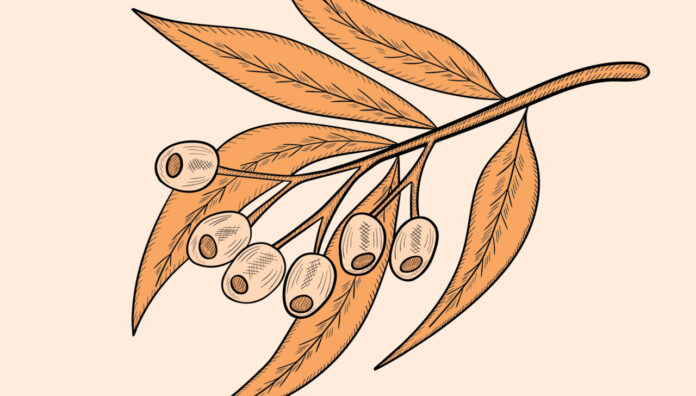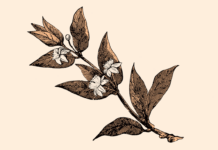Eucalyptus oil was Australia’s first product export.
Among colonial settlers, the healing potential of eucalyptus oil caught on quickly. First Fleet surgeons Dennis Considen and John White exploited the oil distilled from eucalyptus trees growing on the shores of Port Jackson. Learning from First Nations peoples who used it for medicinal and cleaning purposes, what White called the ‘olfactory oil’ was used to treat convicts and marines for joint pain, wounds, infections and various skin conditions.1–3
In fact, word had already leaked. In 1788 French botanist Charles L’Héritier de Brutelle described the genus Eucalyptus, based on a specimen of Eucalyptus obliqua (Stringybark) from Adventure Bay on Bruny Island, Tasmania. It had been collected in 1777 during Captain Cook’s voyage.4
But sales of the fragrant oil really took off in the mid-1800s, thanks to an enterprising young pharmacist. In 1852 Joseph Bosisto opened Australia’s first commercial distillery at Dandenong Creek in Victoria and began vigorously promoting the therapeutic ‘golden oil’.5
By the 1880s Bosisto’s Eucalyptus Oil had begun selling in Europe, Asia and North America. Soon seeds were distributed internationally, and Australian producers began facing stiff competition. Would the local industry survive?1,5
What went global?
Eucalyptus is a member of the Myrtaceae family, comprising 900 species and subspecies. The most popular variety, locally and internationally, soon became the Tasmanian Blue Gum, Eucalyptus globulus. Not only did it provide Bosisto-like ‘golden oil’, the fast-growing tree served the Asian timber and pulp industries. The result: one plant, multiple products, big profits.1,2
By the end of World War II, overseas production (in countries such as Spain, South America, Portugal and China)dominated the industry. Australian producers could not compete. Only small quantities of eucalyptus oil were produced locally … until the early 1990s.1,5
What came back?
Back then, West Australian grain farmers faced rising water tables and, therefore, increased soil salinity. To counter resulting crop damage, they planted Eucalyptus kochii (Trayning Mallee) a native WA species. Salinity was reduced, income increased and the eucalyptus oil industry revived.1,6
Coincidentally, Bosisto’s successors had begun enjoying an emerging global interest in the traceability and sustainability of botanicals, triggering a return to Australia as a source of ‘natural’ eucalyptus oil.5
What is eucalyptus oil?
Eucalyptus oil is an aromatic, colourless or pale-yellow liquid distilled from the fresh leaves of various eucalyptus species. Its primary ingredient is eucalyptol, that is 1,8-cineole or cineole. Other components are limonene and α-terpineol. 2,5,7
These components stimulate antiseptic and anti-inflammatory activity. They also activate macrophages and other immune cells.8,9
Roughly a dozen eucalypt species are used medicinally. Among these are E. globulus, E. polybractea, E. smithii, E. maiden, E bicostata and E. sideroxylon.2
Uses today and tomorrow
Eucalyptus is a complementary medicine listed by the Therapeutic Goods Administration. Some current uses are muscle aches and pain, cough and cold, wounds and personal hygiene.
Experts are also investigating its antimicrobial, anti-oxidant, anti-inflammatory and anti-viral properties for disease treatment and prevention. The potential is huge: from COVID-19 to cancer, bronchitis, malaria, even diabetes, Alzheimer’s and more.2,5,7,10–12
References
- Penny. The history of eucalyptus oil production in Australia. 2020.
- Chandorkar N, Tambe S, Amin P, et al. A systematic and comprehensive review on current understanding of the pharmacological actions, molecular mechanisms, and clinical implications of the genus Eucalyptus. Phytomed Plus 2021;1(4):100089.
- White J. Journal of a voyage to New South Wales. 1790.
- Kantvilas G. The discovery of Tasmanian eucalypts: an historical sketch. Tasforests 1996;8.
- Bosisto’s. Our Story. Felton Grimwade & Bosistos. 2024.
- Florabase – The Western Australian Flora, Department of Biodiversity, Conservation and Attractions. Eucalyptus kochii Western Australian Herbarium. 1998.
- Galan DM, Ezeudu NE, Garcia J, et al. Eucalyptol (1,8-cineole): an underutilized ally in respiratory disorders? J Essent Oil Res 2020;32(2):103–10.
- Zonfrillo M, Andreola F, Krasnowska EK, et al. Essential Oil from Eucalyptus globulus (Labill.) Activates Complement Receptor-Mediated Phagocytosis and Stimulates Podosome Formation in Human Monocyte-Derived Macrophages. Molecules 2022; 27(11):3488.
- National Cancer Institute. Dictionary of Cancer Terms. Macrophage.
- Australian Government Department of Health & Aged Care. Therapeutic Goods Administration. Eucalyptus. 2024.
- DRUGBANK Online. Eucalyptus oil. 2024.
- Mount Sinai. Health Library. Eucalyptus. 2024.



 Pharmacists have always prescribed, but they have the potential to prescribe much more
Pharmacists have always prescribed, but they have the potential to prescribe much more



 Sponsorship information
Sponsorship information


 Talking to patients who have questions
Talking to patients who have questions







